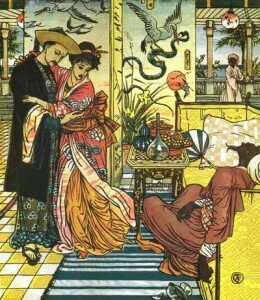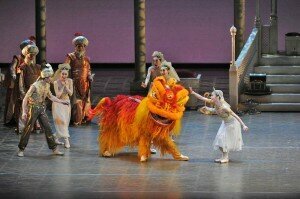
The cover of Burton’s 1885 edition
Burton’s translation, due to his focus on the sensual nature of the stories, was issued in a private publication; earlier translations of the stories, starting around 1850, had both heavily abridged and bowdlerized the stories.

Paul Klee: Sinbad the Sailor (ca. 1928)
The characters in the tales include Sinbad and his seven voyages, tales of the virtuous Harun al-Rashid, Aladdin and his wonderful lamp, Ali Baba and the Forty Thieves, and so on. Composers who take on the tales have focused either on Scheherazade herself as a teller of tales or on the tales themselves.

Leon Bakst’s costumes for the Ballet Russes setting of
Rimsky-Korsakov’s Shéhérazade
Rimsky-Korsakov: Sheherazade, Op. 35: I. The Sea and Sinbad’s Ship (Hans Maile, violin; Georg Donderer, cello; Berlin Radio Symphony Orchestra (Radio-Sinfonie-Orchester Berlin); Hanns-Martin Schneidt, cond.)
Maurice Ravel also took up the teller of tales in his Shéhérazade, or rather, in his two works by that title. The first is a concert overture, written in 1898, and is Ravel’s earliest surviving orchestral work. His second work, written 4 years later, takes the form of a song cycle. Here, Scheherazade is given voice to wish she could travel as widely as did the people in her stories.
Ravel: Shéhérazade: No. 1. Asie (Gisella Pasino, mezzo; Berlin Radio Symphony Orchestra (Radio-Sinfonie-Orchester Berlin); Hanns-Martin Schneidt, cond.)

Walter Crane: Aladdin (1874)
Adams: Scheherazade.2: III. Scheherazade and the Men with Beards (Leila Josefowicz, violin; St. Louis Symphony; David Robertson, – Conductor)
Beyond Scheherazade herself, her individual stories have inspired composers. We find François-Adrien Boieldieu’s Le calife de Bagdad (1800), Carl Maria von Weber’s Abu Hassan (1811), Luigi Cherubini’s Ali Baba (1833), but more than any of these is the story of Aladdin.
Luigi Cherubini: Ali Baba, ou Les quarante voleurs: Overture (NBC Symphony Orchestra ; Arturo Toscanini, cond.)
For those that think of the 1001 Nights stories as being solely set in the Middle East, it will be a surprise to discover that in Burton’s translation, Aladdin is a poor Chinese boy. He is fooled by a Middle Eastern magician into retrieving a magical lamp for him. Aladdin inadvertently activating the jinni in the lamp and so his adventures ensue.

The Lion Dance in Aladdin, Birmingham Royal Ballet
Nielsen: Aladdin Suite, Op. 34: V. The Marketplace in Isaphan (South Jutland Symphony Orchestra; NiklasW illén, cond.)
Christian Horneman, in his only opera, took up the story of Aladdin in 1888. His overture remains the best known of all his works.
Horneman: Aladdin: An Adventure Overture for Orchestra (Aalborg Symphony Orchestra ; Owain Arwel Hughes, cond.)
American composer Edgar Stillman Kelley wrote his Aladdin Suite in San Francisco in 1893. Conceived as a ‘Chinese Suite,’ it was one of the first American works to look to the resources of Chinatown for inspiration of its orchestration.
Kelley: Aladdin, Op. 10: I. At the Wedding of Aladdin and the Princess (Federico Jose Piantini, violin; Patrick Mercuri, mandolin; Symphony Orchestra of America; Matthew H.Phillips, cond.)
We’ll close with one more unfamiliar Aladdin, this one written by Carl Davis for the Scottish Ballet in 2000. He also took up the Chinese elements of the tale, including not one but two Lion Dances into the tale.
Davis: Aladdin: Act II Scene 3: The Sultan’s Audience Chamber: Lion Dance – No. 28e. Magician into Lampseller (Malaysian Philharmonic Orchestra; Carl Davis, cond.)
From the Middle East to the Far East, the tales told by Scheherazade live on.







